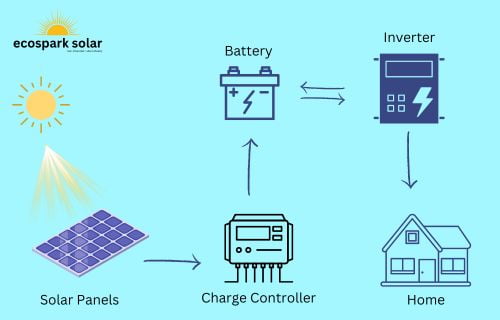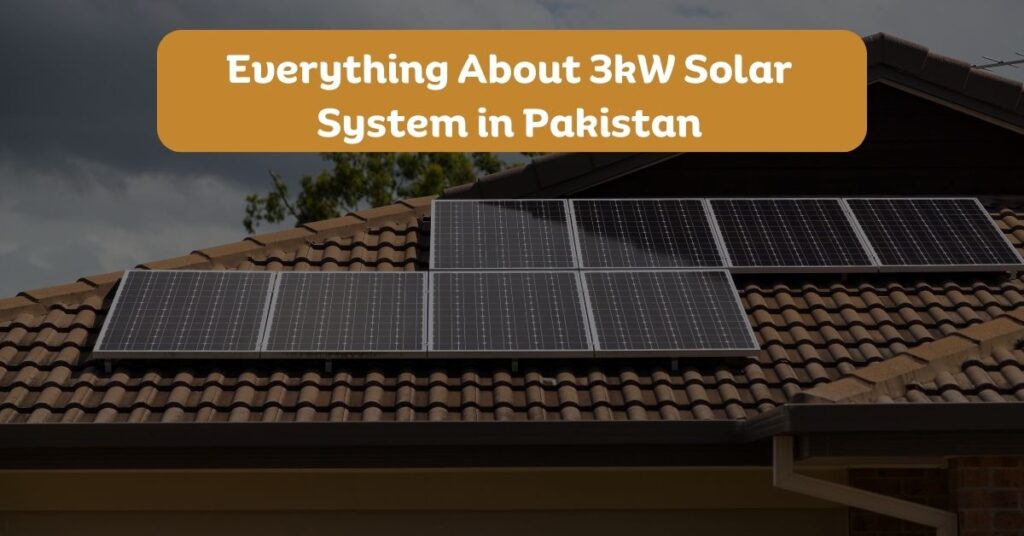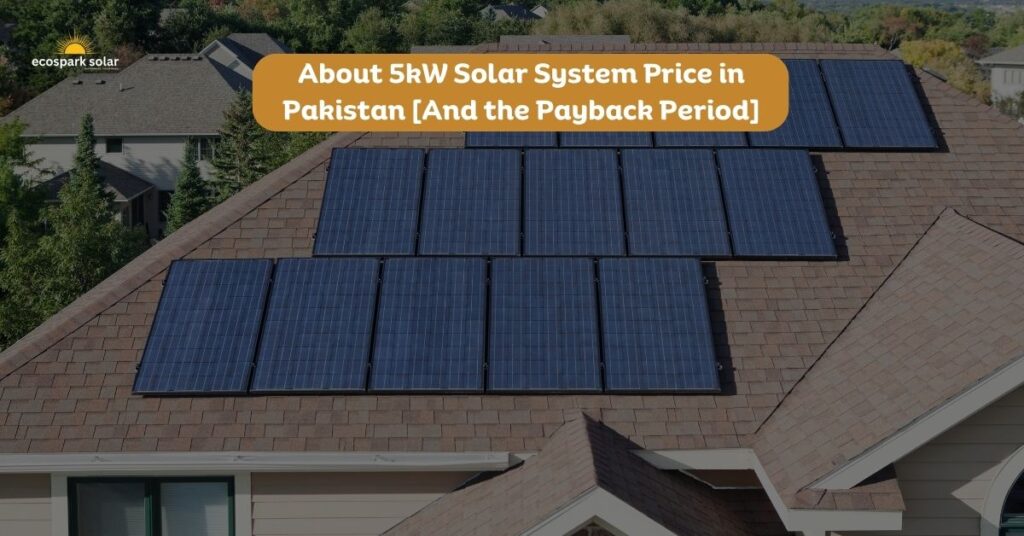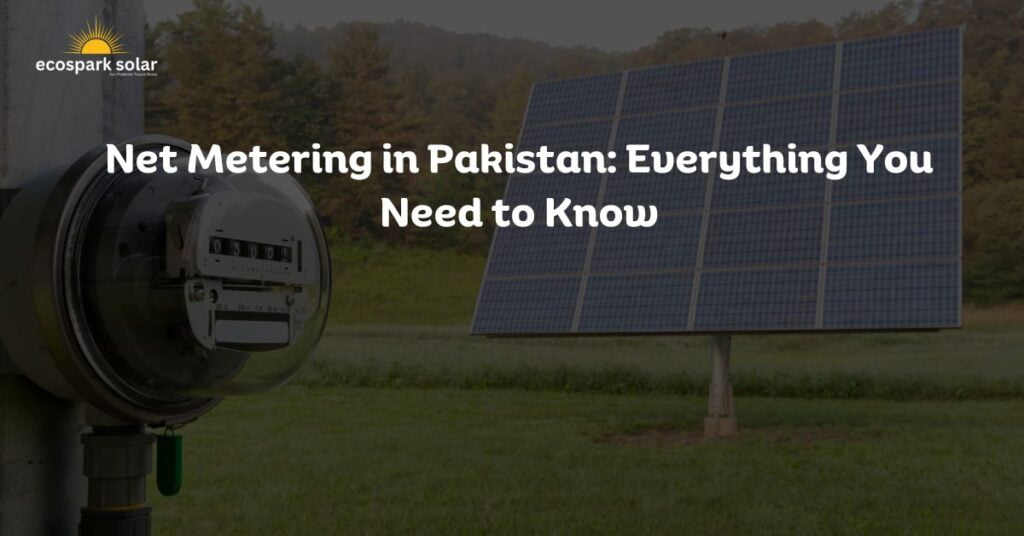Solar installations offer various options for powering your home. You can choose to connect your system to the grid (WAPDA) or rely solely on batteries in an off-grid setup. Or, you could also explore a hybrid system that combines the best of both worlds—your system will be connected both to the grid and batteries.
On-grid vs. off-grid vs. hybrid solar system—which one should you go for in Pakistan? And what are the differences between the three?
Read on. In this article, we aim to help you understand everything you need to know about on-grid, off-grid, and hybrid installation arrangements.
Specifically, we will break down the article into the following:
- Grid-tied solar system and its advantages and limitations
- Off-grid solar system and its advantages and limitations
- Hybrid solar system and its benefits and limitations
- How to choose the right system?
On-Grid vs. Off-Grid vs. Hybrid Solar
Let’s begin with grid-tied solar systems, also known as on-grid and grid-connected solar systems.
On-Grid Solar Systems (aka Grid-Tied Solar Systems)

A grid-tied solar system involves connecting your solar setup to the local electrical grid without incorporating batteries for energy storage. During the daytime, you consume the electricity generated by your solar panels, while at night or during power outages, you rely on grid electricity.
Also referred to as on-grid, grid-interactive, grid-connect, or grid-feed systems, they are the most popular solar installation type in Pakistan. And why not? It gives homeowners and businesses an opportunity to sell their excess electricity through the net metering program. While we lack the exact data, based on our estimates, around 70% of solar systems installed in Pakistan are on-grid.
This trend is recently changing, and people are shifting more towards hybrid solar systems, thanks to solar battery technology advancements—more on this in the later sections of this article.
Advantages of Grid-Tied Solar Systems
- Net metering: One of the primary benefits of on-grid solar systems is net metering. It is a billing arrangement with the grid (IESCO, PESCO, LESCO, etc.) that allows the excess electricity generated by your system to be fed back into the grid. You get energy credits against the exported electricity that offset your electricity bill.
- Continuous power availability: Grid-tied systems ensure a constant power supply, even during periods of low solar generation. For example, when there is no solar at night, you readily export water from WAPDA.
- Flexibility in system sizing: You can size your on-grid solar system tailored to specific energy needs, such as powering specific appliances or subsystems.
- Cost-effectiveness: Grid-tied arrangements are generally more cost-effective as they eliminate the need for additional equipment, like backup generators, batteries, and charge controllers. Moreover, you can adjust the system size according to your budget.
Disadvantages of On-Grid Solar Systems
- Dependency on the grid: During a power outage, grid-tied systems automatically shut down for safety reasons, limiting your access to electricity. For instance, when there is load shedding, your solar system won’t give you power, even if it is generating power. It is for safety reasons.
Equipment Required for On-Grid Solar Systems
To set up a grid-tied solar system, you will need the following:
- Solar panels, of course: Choose the appropriate type of solar panels for your needs. Panels can come in various types, such as monocrystalline, polycrystalline, and PERC panels. They can also come in various capacities, ranging from 150 to more than 550W.
- Solar inverters: Both central inverters and micro-inverters are compatible with grid-tied setups. Your installer will help you choose the right size so that it never trips while functioning.
- Power meter: A specialized meter that tracks two-way electricity flow, allowing seamless integration with the grid. In Pakistan, this meter comes in green color and can accurately monitor both the incoming and outgoing electricity.
If you want to read more about on-grid systems, read our detailed guide to grid-tied systems in Pakistan.
Off-Grid Solar Systems

Off-grid systems operate independently, without any connection to the electrical grid. They utilize batteries to store excess electricity generated during the day for use at night or during periods of low solar generation. Popular in remote areas and regions where extending power transmission lines is costly, off-grid solar systems provide energy independence and clean power consumption.
However, they also present challenges, such as battery maintenance and limited power availability during adverse weather conditions. Given the challenges an off-grid system presents, they are not very feasible for urban centers like Islamabad, Rawalpindi, Peshawar, etc.
A solar system for everyone.
We’re customer-centric; we will find you a solution within your budget. Whatever your project size, you can always save with Ecospark Solar.
Advantages of an Off-Grid Solar System
- Energy independence: Off-grid systems free you from reliance on grid electricity, eliminating electricity bills and potential rate fluctuations. You are in the driver’s seat of controlling your energy supply and consumption.
- Cost-effectiveness in remote locations: Off-grid arrangements are often more affordable than extending power lines to remote areas or agricultural land.
- Clean and green energy: All the electricity generated by an off-grid system is eco-friendly and derived from sustainable sources. So, if you are a climate-conscious individual, this is the type of arrangement that would excite you.
- Uninterrupted power supply: With a rightly-sized off-grid systems, you have a constant access to electricity, even during grid outages. But only for a few days. If the inclement weather extends for more than 7 days and your batteries are empty, you will have to wait for the sun to come up and recharge your system.
Limitations of Off-Grid Solar
- Higher upfront costs: Off-grid systems require additional investment, with initial costs approximately 30-40% higher than grid-tied systems. Additional expenses may be incurred if backup generators are necessary.
- Lack of net metering: Without a grid connection, surplus electricity cannot be sold back to the utility.
- Battery maintenance: Regular battery maintenance is necessary, adding to the long-term costs of an off-grid system. Battery lifespan varies, with some requiring replacement after 4-5 years, affecting the system’s overall solar payback period.
- Limited power during adverse weather: Extended periods of cloudy weather can reduce the available electricity stored in the battery bank, potentially leading to power shortages.
- Space requirements: Accommodating the battery bank and backup generator might pose challenges if you have limited space.
You May Want to Read: How Much Power Do Solar Panels Produce?
Equipment Required for Off-Grid Solar Systems
To design a completely off-grid system, you will need the following:
- Solar panels: Select panels suitable for your specific needs.
- Off-grid inverter: Inverters convert the direct current (DC) electricity from the panels into alternating current (AC) electricity for use in your home. Make sure that your inverter is designed for an off-grid solar system.
- Battery bank: Stores excess electricity for use when solar generation is low. Read.
- Charge controller: Regulates the flow of electricity from the panels to the battery bank, preventing overcharging.
- Backup generator (optional): Provides additional power generation during extended periods of low solar output.
- Additional DC connect switch: Enables safe disconnection of the solar system when required.
Want to explore more about off-grid systems? Read our comprehensive guide to off-grid systems in Pakistan.
Hybrid Solar Systems

A hybrid solar system combines the characteristics of grid-tied and off-grid setups. It allows you to connect your solar system to the grid while incorporating batteries for energy storage.
In this arrangement, surplus energy is stored in the batteries, and any excess beyond the battery capacity is sent back to the grid. This gives you complete immunity from power outages. During the day, you use electricity generated by your solar panels. During the hours of low solar capacity, such as night, you use WAPDA electricity. And during load shedding? Long live your batteries!
Hybrid systems have gained popularity with the introduction of efficient batteries with improved lifespans. They provide a balance between energy independence and grid connectivity, offering continuous power availability.
Related Read: How to Size Your Hybrid Solar System?
Advantages of Hybrid Solar Systems
- Reduced reliance on grid electricity: Hybrid systems minimize dependence on the grid by using stored energy during low solar generation periods, resulting in lower electricity bills.
- Continuous power supply: Hybrid systems ensure an uninterrupted power supply, even during grid outages or adverse weather conditions.
- Enhanced savings: By reducing reliance on the grid and through net metering, where excess electricity can be sold back to the utility, hybrid systems offer potential cost savings.
- Expandability: Hybrid systems provide flexibility for future expansion, allowing you to add more panels or batteries as needed.
Disadvantages of Hybrid Solar Systems
- Higher initial investment: Hybrid systems require a higher upfront investment than grid-tied systems, although the cost is lower compared to off-grid setups, as backup generators and large battery banks are not typically required.
- Space requirements: Hybrid systems may require dedicated space for the battery bank and other equipment.
Equipment Required for Hybrid Solar Systems
To install a hybrid solar system, you will need the following:
- Solar panels
- Hybrid inverter
- Battery bank
- Charge controller
- Power meter—the green meter we talked about above.
- Additional DC connect switch—it facilitates safe disconnection of the solar system when necessary.
If you want to read more on hybrid solar, read our explainer on hybrid solar systems in Pakistan.
On-Grid vs. Off-Grid vs. Hybrid Solar Systems: A Table of Comparison
| Type of Solar System | Grid-Tied | Off-Grid | Hybrid |
| Grid Connection | Connected to the grid | Not connected to the grid | Connected to the grid |
| Energy Storage | No batteries | Battery bank required for nighttime use | Battery bank for energy storage |
| Power Availability | Reliant on grid during low solar generation | Reliant on stored energy in batteries | Uses stored energy and can access grid when needed |
| Cost | Cost-effective | Higher upfront costs | Higher initial investment than grid-tied, but lower than off-grid |
| Net Metering | Yes, surplus electricity can be sold back to the grid | Not applicable, not connected to the grid | Yes, excess power can be sold to the utility |
| Power Independence | Reliant on the grid during power outages | Independent from the grid, continuous power supply | Reduced reliance on the grid, continuous power supply |
| Space Requirements | No additional space needed | Space required for battery bank and backup generator (if applicable) | Space required for battery bank |
| Suitability | Areas with reliable grid connections | Remote areas or where grid connections are costly | Areas with intermittent power supply and desire for energy independence |
| Flexibility/Expandability | Can install as many panels as desired | Limited flexibility due to off-grid setup | Flexible and expandable like grid-tied systems |
Grid-Tied vs. Off-Grid vs. Hybrid Solar Systems: Which One Should You Choose?
Each solar installation type has its advantages and disadvantages—we discussed some of them in the lines above. The choice depends on your preferences, needs, lifestyle, location, and budget. But here are our two cents on each system type.
- Grid-tied systems are suitable for areas with reliable grid connections and minimal power outages. They offer flexibility and cost-effectiveness, especially when net metering is available. You will be aware of load shedding in your area. If it is manageable, then grid-tied systems are the best, as it saves you big in the long run.
- Off-grid systems are ideal for remote locations, or areas where connecting to the grid is cost-prohibitive. They provide energy independence but require careful consideration of battery maintenance, weather conditions, and higher upfront costs. If you are in remote areas of Dir, Kohistan, or Shangla, or intend to use it for agricultural use where there is no electricity, go for off-grid systems.
- Hybrid systems offer a balanced approach, combining the benefits of grid-tied and off-grid setups. They reduce reliance on the grid, provide continuous power supply, offer potential cost savings, and allow for future expansion. However, they require a higher initial investment and adequate space. It is better for areas that have a bit more load shedding. But it still saves you enough over the course of your system’s lifespan.
If you are still uncertain about the best option for your needs, we at Ecospark Solar are available to provide personalized advice and suggest an affordable and suitable solution for your household. Contact us today to explore your solar installation options.
Remember, at Ecospark Solar, it is all about our customers!



